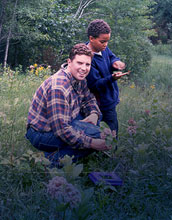Multimedia Gallery
Butterfly Project Adult/child Team
An adult/child team of participants in the Monarch Butterfly Larval Monitoring project look for larvae samples in the field. The Monarch Larva Monitoring Project provides an excellent opportunity for adults to work with children in a fun-filled science program. [One of seven related images. See Next Image.]
More About this Image:
As part of her National Science Foundation (NSF)-supported Monarch Butterfly Larval Monitoring Project, Karen Oberhauser of the University of Minnesota is implementing a nationwide citizen science project focused on the life-cycle of monarch butterflies. Oberhauser and other researchers from the university are training naturalists and environmental educators throughout the U.S. at 11 host sites. Participants in the first round of training will then train volunteer monitors. The target audience for volunteers is adult/child teams, who will monitor a field or patch of milkweed plants--the food plant of monarch caterpillars--for the entire summer. They will count eggs and caterpillars also known as larvae, with the entire group surveying a grand total of more than 25,000 milkweed plants each week.
The project website shows temporal and spatial data and will provide interpretations of volunteer observations. List servers support the project and augment a monthly newsletter and the website. In addition, mini exhibits have been created to highlight the project at participating nature centers. These exhibits focus on monarch and insect ecology and conservation, as well as local and population-wide monitoring efforts. It is estimated that 90-150 nature centers will participate in the regional training and they in turn will train almost 5,000 volunteers. [This research was supported under NSF grant ESI 01-04600.] (Year of image: 2001)
SORRY: THIS IMAGE IS NOT AVAILABLE IN HIGH-RESOLUTION FORMAT
Credit: Sheila Langer, University of Minnesota
Images and other media in the National Science Foundation Multimedia Gallery are available for use in print and electronic material by NSF employees, members of the media, university staff, teachers and the general public. All media in the gallery are intended for personal, educational and nonprofit/non-commercial use only.
Images credited to the National Science Foundation, a federal agency, are in the public domain. The images were created by employees of the United States Government as part of their official duties or prepared by contractors as "works for hire" for NSF. You may freely use NSF-credited images and, at your discretion, credit NSF with a "Courtesy: National Science Foundation" notation.
Additional information about general usage can be found in Conditions.
Also Available:
Download the high-resolution TIFF version of the image. (90 KB)
Use your mouse to right-click (Mac users may need to Ctrl-click) the link above and choose the option that will save the file or target to your computer.

